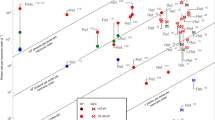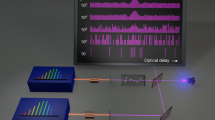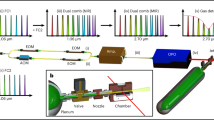Abstract
The development of the optical frequency comb (a spectrum consisting of a series of evenly spaced lines) has revolutionized metrology and precision spectroscopy owing to its ability to provide a precise and direct link between microwave and optical frequencies1,2. A further advance in frequency comb technology is the generation of frequency combs in the extreme-ultraviolet spectral range by means of high-harmonic generation in a femtosecond enhancement cavity3,4. Until now, combs produced by this method have lacked sufficient power for applications, a drawback that has also hampered efforts to observe phase coherence of the high-repetition-rate pulse train produced by high-harmonic generation, which is an extremely nonlinear process. Here we report the generation of extreme-ultraviolet frequency combs, reaching wavelengths of 40 nanometres, by coupling a high-power near-infrared frequency comb5 to a robust femtosecond enhancement cavity. These combs are powerful enough for us to observe single-photon spectroscopy signals for both an argon transition at 82 nanometres and a neon transition at 63 nanometres, thus confirming the combs’ coherence in the extreme ultraviolet. The absolute frequency of the argon transition has been determined by direct frequency comb spectroscopy. The resolved ten-megahertz linewidth of the transition, which is limited by the temperature of the argon atoms, is unprecedented in this spectral region and places a stringent upper limit on the linewidth of individual comb teeth. Owing to the lack of continuous-wave lasers, extreme-ultraviolet frequency combs are at present the only promising route to extending ultrahigh-precision spectroscopy to the spectral region below 100 nanometres. At such wavelengths there is a wide range of applications, including the spectroscopy of electronic transitions in molecules6, experimental tests of bound-state and many-body quantum electrodynamics in singly ionized helium and neutral helium7,8,9, the development of next-generation ‘nuclear’ clocks10,11,12 and searches for variation of fundamental constants13 using the enhanced sensitivity of highly charged ions14.
This is a preview of subscription content, access via your institution
Access options
Subscribe to this journal
Receive 51 print issues and online access
$199.00 per year
only $3.90 per issue
Buy this article
- Purchase on Springer Link
- Instant access to full article PDF
Prices may be subject to local taxes which are calculated during checkout




Similar content being viewed by others
References
Udem, T., Holzwarth, R. & Hänsch, T. W. Optical frequency metrology. Nature 416, 233–237 (2002)
Cundiff, S. T. & Ye, J. Femtosecond optical frequency combs. Rev. Mod. Phys. 75, 325–342 (2003)
Jones, R. J., Moll, K. D., Thorpe, M. J. & Ye, J. Phase-coherent frequency combs in the vacuum ultraviolet via high-harmonic generation inside a femtosecond enhancement cavity. Phys. Rev. Lett. 94, 193201 (2005)
Gohle, C. et al. A frequency comb in the extreme ultraviolet. Nature 436, 234–237 (2005)
Ruehl, A., Marcinkevicius, A., Fermann, M. E. & Hartl, I. 80 W, 120 fs Yb-fiber frequency comb. Opt. Lett. 35, 3015–3017 (2010)
Merkt, F. & Softley, T. P. Final-state interactions in the zero-kinetic-energy-photoelectron spectrum of H2 . J. Chem. Phys. 96, 4149–4156 (1992)
Herrmann, M. et al. Feasibility of coherent XUV spectroscopy on the 1S–2S transition in singly ionized helium. Phys. Rev. A 79, 052505 (2009)
Kandula, D. Z., Gohle, C., Pinkert, T. J., Ubachs, W. & Eikema, K. S. E. Extreme ultraviolet frequency comb metrology. Phys. Rev. Lett. 105, 063001 (2010)
Eyler, E. E. et al. Prospects for precision measurements of atomic helium using direct frequency comb spectroscopy. Eur. Phys. J. D 48, 43–55 (2008)
Peik, E. & Tamm, C. Nuclear laser spectroscopy of the 3.5 eV transition in Th-229. Europhys. Lett. 61, 181–186 (2003)
Rellergert, W. G. et al. Constraining the evolution of the fundamental constants with a solid-state optical frequency reference based on the 229Th nucleus. Phys. Rev. Lett. 104, 200802 (2010)
Campbell, C. J., Radnaev, A. G. & Kuzmich, A. Wigner crystals of 229Th for optical excitation of the nuclear isomer. Phys. Rev. Lett. 106, 223001 (2011)
Murphy, M. T., Webb, J. K. & Flambaum, V. V. Further evidence for a variable fine-structure constant from Keck/HIRES QSO absorption spectra. Mon. Not. R. Astron. Soc. 345, 609–638 (2003)
Berengut, J. C., Dzuba, V. A., Flambaum, V. V. & Ong, A. Electron-hole transitions in multiply charged ions for precision laser spectroscopy and searching for variations in alpha. Phys. Rev. Lett. 106, 210802 (2011)
Krausz, F. & Ivanov, M. Attosecond physics. Rev. Mod. Phys. 81, 163–234 (2009)
Bellini, M. et al. Temporal coherence of ultrashort high-order harmonic pulses. Phys. Rev. Lett. 81, 297–300 (1998)
Mairesse, Y. et al. Attosecond synchronization of high-harmonic soft X-rays. Science 302, 1540–1543 (2003)
Yost, D. C. et al. Vacuum-ultraviolet frequency combs from below-threshold harmonics. Nature Phys. 5, 815–820 (2009)
Pinkert, T. J. et al. Widely tunable extreme UV frequency comb generation. Opt. Lett. 36, 2026–2028 (2011)
Eckstein, J. N., Ferguson, A. I. & Hänsch, T. W. High-resolution two-photon spectroscopy with picosecond light pulses. Phys. Rev. Lett. 40, 847–850 (1978)
Allison, T. K., Cingöz, A., Yost, D. C. & Ye, J. Extreme nonlinear optics in a femtosecond enhancement cavity. Phys. Rev. Lett. 107, 183903 (2011)
Carlson, D. R., Lee, J., Mongelli, J., Wright, E. M. & Jones, R. J. Intracavity ionization and pulse formation in femtosecond enhancement cavities. Opt. Lett. 36, 2991–2993 (2011)
Hartl, I. et al. Cavity-enhanced similariton Yb-fiber laser frequency comb: 3×1014 W/cm2 peak intensity at 136 MHz. Opt. Lett. 32, 2870–2872 (2007)
Schibli, T. R. et al. Optical frequency comb with submillihertz linewidth and more than 10 W average power. Nature Photon. 2, 355–359 (2008)
Eidam, T. et al. Femtosecond fiber CPA system emitting 830 W average output power. Opt. Lett. 35, 94–96 (2010)
Yost, D. C., Schibli, T. R. & Ye, J. Efficient output coupling of intracavity high-harmonic generation. Opt. Lett. 33, 1099–1101 (2008)
Ozawa, A. et al. High harmonic frequency combs for high resolution spectroscopy. Phys. Rev. Lett. 100, 253901 (2008)
Lee, J., Carlson, D. & Jones, R. J. Optimizing intracavity high harmonic generation for XUV fs frequency combs. Opt. Express 19, 23315–23326 (2011)
Ye, J., Ma, L.-S. & Hall, J. L. Molecular iodine clock. Phys. Rev. Lett. 87, 270801 (2001)
Minnhagen, L. Spectrum and the energy levels of neutral argon, Ar I. J. Opt. Soc. Am. 63, 1185–1198 (1973)
Acknowledgements
We thank J. L. Hall for the use of an iodine-stabilized laser, M. D. Swallows for the assistance with the hydrogen maser frequency transfer, and S. T. Cundiff and A. Foltynowicz for reading a draft of the manuscript. This research is funded by the DARPA, AFOSR, NIST and NSF. A.C. and T.K.A. are National Research Council postdoctoral fellows. A.R. acknowledges funding from the Alexander von Humboldt Foundation (Germany).
Author information
Authors and Affiliations
Contributions
A.C., D.C.Y., T.K.A. and J.Y. conceived of, designed and carried out the XUV power and spectroscopy measurements. A.R., M.E.F. and I.H. designed and built the Yb:fibre laser. All authors discussed the results and worked on the manuscript.
Corresponding authors
Ethics declarations
Competing interests
The authors declare no competing financial interests.
Supplementary information
Supplementary Information
This file contains Supplementary Figure 1 with legend, Supplementary Text and Data, which includes details on the femtosecond enhancement cavity design as well as the comb tooth number determination. (PDF 394 kb)
Rights and permissions
About this article
Cite this article
Cingöz, A., Yost, D., Allison, T. et al. Direct frequency comb spectroscopy in the extreme ultraviolet. Nature 482, 68–71 (2012). https://doi.org/10.1038/nature10711
Received:
Accepted:
Published:
Issue Date:
DOI: https://doi.org/10.1038/nature10711
This article is cited by
-
Near-ultraviolet photon-counting dual-comb spectroscopy
Nature (2024)
-
Simulation of Light Intensity of VUV Lamp Based on Inductively Coupled Plasma Discharge in Low-pressure Kr-He Mixture
Plasma Chemistry and Plasma Processing (2024)
-
Scheme for the excitation of thorium-229 nuclei based on electronic bridge excitation
Nuclear Science and Techniques (2023)
-
Resonant X-ray excitation of the nuclear clock isomer 45Sc
Nature (2023)
-
Ultra-short-pulse high-average-power megahertz-repetition-rate coherent extreme-ultraviolet light source
PhotoniX (2021)
Comments
By submitting a comment you agree to abide by our Terms and Community Guidelines. If you find something abusive or that does not comply with our terms or guidelines please flag it as inappropriate.



